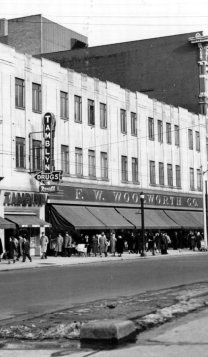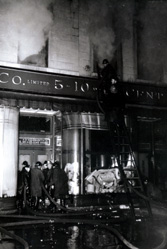THE HEART OF THE CITY
F.W. WOOLWORTH CO. LTD.
| 105-109 King Street
East |
19-31 King Street East |
 CURRENT STATUS (1999) CURRENT STATUS (1999)
Present Owner: J. Ginsberg
Present Use: #105: The Rainbow
Shops Formal Wear; #107: vacant; #109: Tom Houston Imports
Heritage Status: Listed on the City's Inventory
of Buildings of Architectural and / or Historical Interest
Locally Significant Date: Early Twentieth
Century  BUILDING INFORMATION BUILDING INFORMATION
Date Built: 1921; third storey added at rear
in 1964
Original Owner: Spectator Printing Company
(land owned by Mills Brothers)
Original Use: #105-109: F.W.
Woolworth
Subsequent Uses: 1964-present: Rainbow
Shops Formal Wear; 1952, G. Gaul, jeweller; 1921-35: Laura Secord
Previous Building on Site: Unknown
 ARCHITECTURE ARCHITECTURE
Size: Three-storey
Design and Style: N/A
Architect, Builder: Unknown
Construction Materials: Brick masonry;
facing of Queenston and Indiana limestone added in 1950s
Architectural Integrity: Moderate
Architectural Features:
Simple lines, unadorned facade, windows banded together
|
 CURRENT STATUS (1999) CURRENT STATUS (1999)
Present Owner: Aragon
Present Use: Tax preparation and
chartered accountants
Heritage Status: Listed on the City's Inventory
of Buildings of Architectural and / or Historical Interest
Locally Significant Date: Early Twentieth
Century  BUILDING INFORMATION BUILDING INFORMATION
Date Built: 1949 (with major renovation
project in 1966)
Original Owner: F.W. Woolworth Company Ltd. Original Use: N/A
Subsequent Uses: Valaitis & Associates;
KPMG; D. Foti
Previous Building on Site: Unknown
 ARCHITECTURE ARCHITECTURE
Size: Three-storeys
Design and Style: Art Deco / pre-modern
Architect, Builder: Ryan Construction
Company
Construction Materials: Facade: cut
stone Architectural Integrity: Good (upper facade virtually intact)
Architectural Features:
Long and relatively low facade articulated by typical Art Deco features: narrow and
wide piers (dividing window bays) terminated by low relief geometric elements; incised
angular motif in the stone panel over each window; original steel-framed windows, each
comprising two narrow panes with a transom light above
|

The King Street F.W. Woolworth Department Store was one
in a chain of stores named for their founder Frank Winfield Woolworth. The first Woolworth
Department store opened in 1879 in Utica, New York. Soon after its opening, the store
failed. Another Woolworth Store was later opened in Lancaster; Pennsylvania and was a
great success. The first purchase made, a five-cent fire shovel, gave birth to the
"five and dime" motto that would remain characteristic of the store until its
closing.
As a retailer and businessman, Frank Winifield Woolworth
established precedents that continue today. He was the first mass merchant to buy direct
from the manufacturer, and to introduce and establish fixed prices at a time when
bargaining was the common practice. He was also of the first retailers to place
merchandise on counters allowing for customer-purchase interaction.
The first F.W. Woolworth Store to open in Canada was on
April 30, 1879, by H.S. Knox of Toronto. Soon after, E.P. Charleton opened a store in
Montreal and five years later in 1902, the first Hamilton Woolworth store was opened on
King Street. There were "lots of bargains and lots of products – from toilet
paper to cream pies to parakeets", as period advertisements claimed. The store was to
remain in this location for only ten years when the firm decided that larger facilities
were needed. The company then moved to a three-storey building where they were to remain
for almost 35 years.
 In
March 1947, a fire started in the basement of the store and by the end, had completely
destroyed the F.W. Woolworth Building and all its contents. As stated by Fire Chief
Murdoch: "In a building of this type three storeys high and each floor from 75 to 100
feet wide with no partitions, it is only a matter of minutes until an intense heat is
generated and then there is a flash flame which sweeps everything before it"
(Spectator, May 25, 1947). Sixteen hours after the fire was discovered, fire crews
continued to work against the smoldering timbers. The three-storey building made of
structural steel and reinforced concrete was destroyed. The foundation of the Right House suffered damage, the basement was flooded with nearly
five feet of water, and every floor suffered smoke damage. Other businesses to suffer
smoke and water damage included: Bowle’s Lunch, Loblaw Groceteria, Tamblyn’s
Drug Store, and Northway’s Stores.
In
March 1947, a fire started in the basement of the store and by the end, had completely
destroyed the F.W. Woolworth Building and all its contents. As stated by Fire Chief
Murdoch: "In a building of this type three storeys high and each floor from 75 to 100
feet wide with no partitions, it is only a matter of minutes until an intense heat is
generated and then there is a flash flame which sweeps everything before it"
(Spectator, May 25, 1947). Sixteen hours after the fire was discovered, fire crews
continued to work against the smoldering timbers. The three-storey building made of
structural steel and reinforced concrete was destroyed. The foundation of the Right House suffered damage, the basement was flooded with nearly
five feet of water, and every floor suffered smoke damage. Other businesses to suffer
smoke and water damage included: Bowle’s Lunch, Loblaw Groceteria, Tamblyn’s
Drug Store, and Northway’s Stores.
In 1948, a new building, located on the north side of
King Street between James and Hughson Streets was erected. The estimated cost of the new
Woolworth’s was $750,000. The company took a forty-year lease on the building. The
new location had a frontage of approximately 74 feet which was considerably larger than
the previous frontage of 56 feet. The new store was also to extend over the frontage of
the former Bowle’s Lunch. Air conditioning and modern escalators were added. The
basement and main floor were used for retail purposes while the sub-basement housed the
heating and storage areas. The store also increased and varied their stock.
By 1961, F.W. Woolworth Co. had become a major downtown
property owner. The company had negotiated with the Mills Bros. Ltd., a family owned real
estate and investment corporation, which had large holdings in the core of the city for
generations. The Mills Bros. Ltd. transferred their three-storey
building and land to the Woolworth Company thereby increasing their frontage to 110 feet
opposite Gore Park. By 1961, there were four Woolworth Stores in Hamilton: one on Ottawa Street, one on King Street and two mountain
locations.
Ottawa Street, one on King Street and two mountain
locations.
In 1966, the store spent nearly $450,000 on renovations.
The former window displays were to be replaced by large windows providing a panoramic view
of the interior. There was new lighting, new display counters, larger aisles and a freshly
painted interior. Pastel shades (light blues, beiges, pinks, and greens) coloured the
walls and the east wall of the store was decorated with volcanic rock imported from
Hawaii.
At its peak, the store had a staff of 300 employees,
predominantly women, a bakery, and a lunch counter that stretched down one side and along
the back. The restaurant featured a menu consisting of everything from light snacks to
full course meals.
In 1990, a firm headed by Toronto lawyers purchased the
store which was then leased back to the Woolworth Corporation until its closure that same
year.
REFERENCES:
Baxter Scrapbook of Clippings. Vol. 6. Special
Collections. HPL.
Bloom Scrapbook, Vol. 2. Special Collections. HPL.
Bloom Scrapbook, Vol. 5. Special Collections. HPL.
Clipping File – Department Stores – F.W. Woolworth. Special Collections. HPL.
Fires in Hamilton Scrapbook. Vol. 1. Special Collections. HPL.
Fires in Hamilton Scrapbook. Vol. 2. Special Collections. HPL.
Fires in Hamilton Scrapbook. Vol. 5. Special Collections. HPL.
Hamilton – Store Hours Scrapbook. Vol. 1. Special Collections. HPL.
King Street Scrapbook. Vol. 1. Special Collections. HPL.
LACAC Research Files. Planning Department, City Hall.


 In
March 1947, a fire started in the basement of the store and by the end, had completely
destroyed the F.W. Woolworth Building and all its contents. As stated by Fire Chief
Murdoch: "In a building of this type three storeys high and each floor from 75 to 100
feet wide with no partitions, it is only a matter of minutes until an intense heat is
generated and then there is a flash flame which sweeps everything before it"
(Spectator, May 25, 1947). Sixteen hours after the fire was discovered, fire crews
continued to work against the smoldering timbers. The three-storey building made of
structural steel and reinforced concrete was destroyed. The foundation of the
In
March 1947, a fire started in the basement of the store and by the end, had completely
destroyed the F.W. Woolworth Building and all its contents. As stated by Fire Chief
Murdoch: "In a building of this type three storeys high and each floor from 75 to 100
feet wide with no partitions, it is only a matter of minutes until an intense heat is
generated and then there is a flash flame which sweeps everything before it"
(Spectator, May 25, 1947). Sixteen hours after the fire was discovered, fire crews
continued to work against the smoldering timbers. The three-storey building made of
structural steel and reinforced concrete was destroyed. The foundation of the Ottawa Street, one on King Street and two mountain
locations.
Ottawa Street, one on King Street and two mountain
locations.